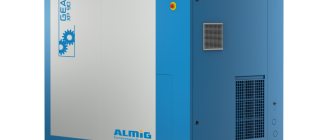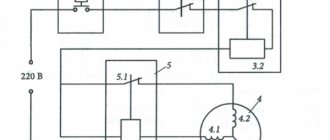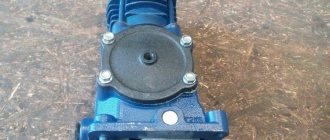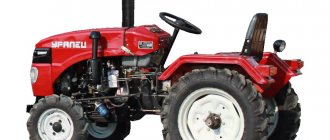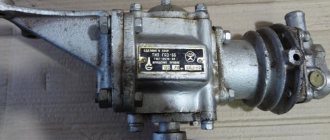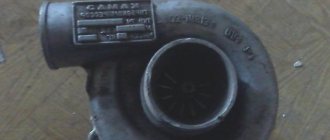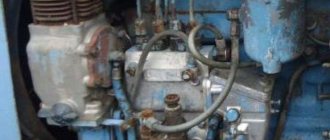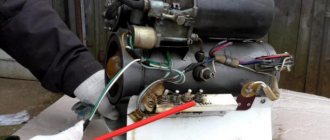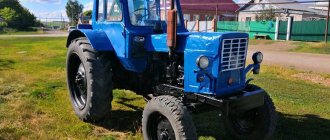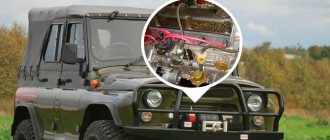Compressor units are widely used in households, in the technical equipment of small workshops and in production. Such equipment allows you to economically generate working force, in some cases relieving the user of the need to directly connect the equipment to the electrical network. But for high-quality service of the target tool, the optimal installation option should be initially determined. At the first stage of selection, the answer to the following question is given: which compressor is better - oil or oil-free? Both options are attractive in their own way, but with different performance qualities.
Design of oil-free compressors
These installations are devoid of lubricating fluids: the parts move relative to each other in a completely dry chamber. High friction increases the operating temperature of surfaces, and to reduce it, manufacturers have provided water injection and low-friction materials. However, the service life of these devices is much shorter than oil ones.
Device design:
- compression chamber;
- piston and piston ring with special coating;
- cylinder with anodized walls;
- bearing;
- crankcase
How to choose a suitable compressor?
- For short-term work with pneumatics at low pressure, an oil-free compressor is better suited;
- For work in the pharmaceutical and food industries, again, the oil-free option is optimal;
- For construction work, as well as in industrial conditions, there is no better option than an oil compressor. Despite the rather high cost, it will fully justify it in this case.
Advantages and disadvantages of oil compressors
The advantages of oil-filled compressors include:
- Lubrication for components equipped with moving parts is a classic solution. Thanks to it, the friction force is reduced, heat is removed, and wear products are removed.
- Oil is an additional sealant, filling the gaps between parts and working chambers.
- In total, this ensures high efficiency, increases engine life, and extends the time of continuous operation.
The disadvantages of meat-type compressors include the need to constantly monitor the fluid level in the system and change it regularly. Plus, as a result of the operation of the equipment, microscopic drops of oil are formed that enter the environment, which significantly limits the scope of application.
Differences during operation
The main differences when operating an oil compressor from an oil-free one:
- Constantly monitoring the oil level and adding it as necessary;
- complete oil change during periodic scheduled maintenance.
Lubricants should be purchased strictly recommended by the manufacturer. Otherwise, in the event of a breakdown, you may lose your warranty, and the likelihood of such a breakdown increases significantly.
Such units must operate in a horizontal position without exceeding the permissible slope specified in the passport. Otherwise, lubrication conditions will deteriorate or oil will simply leak out of the crankcase.
Oil-free machines only require periodic replacement of the piston rings.
Cleaning air filters, checking and servicing fittings on an oil-free compressor is carried out without any differences.
Performance Comparison
There is no direct and unambiguous answer to the question of which compressor is better - oil-filled or oil-free. For large enterprises, models of the first type are more suitable, capable of operating under constant loads for a long time. In addition, they are distinguished by undemanding operating conditions and high wear resistance.
For domestic purposes, it is advisable to use oil-free installations. They perfectly complement almost any equipment in the house and function effectively in those enterprises whose production cycle is associated with the need to supply clean compressed air.
Features of oil-free appliances
Before deciding which compressor to choose, you need to know all the operating features. Oil-free devices are used mainly for certain types of small-scale work. The advantage of oil-free compressors is ease of maintenance: they do not require constant oil changes, which means they are cheaper to operate. However, the service life of such devices is much shorter, since the abrasion of parts is high.
The recommended operating time for an oil-free compressor is up to 15 minutes per hour. If the device is turned on for a longer period of time, it will cause overheating and damage. As a rule, these devices are small in size, easy to move, and light in weight. The price category of this equipment is quite high due to the use of expensive modern material.
Compressor manufacturers
Berg is the world's leading company in the production of industrial equipment, including oil compressors. The classic models of the product line are manufactured in Germany from European components. There is only one assembly shop in Russia for the production of units adapted to the requirements of the Russian buyer. The Belarusian manufacturer of compressor equipment Remeza produces high quality products. The model range is represented by more than 30 modifications, including piston, screw, air, and mobile.
The ABAC brand has been known since 1948, originating from the famous Italian company Balma. The company began producing compressors in 1949. The models meet all international quality and safety criteria, are reliable and have a long service life.
Comaro was founded in Italy in 1992. Today, the brand’s products are known all over the world due to their compliance with European quality traditions, wide technical capabilities, and reliability.
The German company Kraftmann has established itself in the compressor equipment production market since the last century. The product lines include piston, belt, oil-free, oil-filled compressors of various types. The manufacturer is associated all over the world as an enterprise that initially produces high-quality and reliable equipment.
Scope of application
The pros and cons we have indicated do not provide a clear answer to the question of which compressor is better, oil-based or oil-free. To choose the right compressor (with or without oil), you need to determine two main things:
- In what area will it be used?
- At what working pace will it be used?
There are areas of pneumatic application where stringent requirements are established. The rules prohibit the appearance of oil particles in the pumped air. Therefore, oil-free compressors are the only way out. These areas include:
- Medicine. A supply of clean air is needed, for example, in a dental unit.
- Food industry. Compressed air is used to make food products and packaging. Pharmaceuticals. To make medicines, you only need clean air. It should not contain even an amount of impurities.
- Production of upholstered furniture.
- Painting of various elements, including cars. With pneumatic spray guns, oil should not get into the paint in any way.
In addition to such important industries, oil-free compressors are often purchased for small jobs. It is cheaper and quite suitable for working with simple pneumatic tools. For inflating tires and blowing air. Oil-free compressors cannot withstand long cycles. But, for example, a screwdriver does not work for very long. Few seconds. During this time there will be no overheating.
If there are no specific tasks for air purity, then the choice is always in favor of an oil compressor. Its high performance and the ability to achieve the required pressure are used in many industries. Oil-fired units are suitable for daily operation for several hours. Can work for a long time. Oil models are also purchased for household work. At the dacha, in the house, in the garage.
Installation of compressors
Without exception, all compressor units are installed in accordance with the Safety Rules for the operation of stationary compressor units, air ducts, and gas pipelines PB-03-581-03. The regulations describe in detail the requirements for premises for compressor installations. Professionals need to consider:
- equipment location;
- ambient temperature;
- distance from walls;
- availability of ventilation;
- the need for additional airflow from below;
- preventing condensation formation;
- air outlet and supply;
- if necessary, organize additional ventilation.
Which compressor should you prefer: belt or direct?
All compressors according to the type of engine gear are divided into:
- belt;
- relay.
The main difference lies in the available connection features of the piston block, which entails options for connecting the crankshaft. The following methods are distinguished:
- directly through the pulley;
- using belts.
The declared operating life of the unit, including the maximum heating values during operation and the motor life in general, directly depends on the type of transmission used.
Advantages and disadvantages of the direct type compressor
Oil compressors with a direct transmission type are characterized by an increased speed of pumping compressed air, while they are more quickly susceptible to overheating, which significantly reduces their operating period.
Among the main advantages it is customary to highlight:
- rapid production of compressed air in sufficient volume;
- light weight;
- compactness – transportation does not cause difficulties;
- significant energy savings.
The main disadvantages include:
- short service life - unlike belt compressors, they quickly break down and require servicing;
- inability to use continuously for a long time.
Due to the existing shortcomings, we can conclude that such compressors will be an excellent option if it is necessary to solve problems that do not require prolonged injection of compressed air.
Advantages and disadvantages of belt compressor
Belt compressors are distinguished by their slow pumping rates of compressed air (the number of revolutions rarely exceeds 1.1 thousand per minute), but they can be operated for a long period.
The belt drive has the ability to convert the high torque of the electric motor into more significant piston revolutions. Such devices are excellent for working in difficult conditions, for example, at elevated temperatures.
A specially designed belt mechanism has the ability to significantly reduce speed to ensure effective cooling of the electric motor. This automatically increases the period of continuous operation.
Additionally, it is necessary to pay attention to the fact that when the piston jams (this is not uncommon during constant operation), the belt breaks first, thanks to which the engine itself is under reliable protection. The main advantages of such compressors include:
The main advantages of such compressors include:
- high performance indicators;
- the principle of air cooling is used;
- maximum protection of the engine from all kinds of factors affecting its operational life;
- Excellent performance in difficult conditions.
Large dimensions are usually identified as disadvantages. To be able to install the compressor, it becomes necessary to use an exclusively flat surface, since otherwise vibration will increase significantly. In addition, the technician is required to constantly monitor the current condition of the belt (there is often a need to replace it) - often the compressor requires additional maintenance.
Therefore, the disadvantages include:
- slow air pumping;
- heavy weight - moving the compressor without special equipment is quite difficult;
- large dimensions;
- the need to constantly monitor the condition of the belt.
Despite their shortcomings, such models are in great demand in the domestic market.
Popular models
Air compressors are designed for inflating tires, painting production, carrying out construction work, for equipping enterprises in the production of products and services, etc. In each individual case, the parameters for choosing an installation are individual.
Berg VK22R
Oil-filled screw compressor with belt drive, efficient and durable motor with IP55 protection, standard voltage 380V.
The design features an air-cooled oil heat exchanger allowing operation in the hottest conditions. The advantages include:
- low level of noise and vibration;
- fully electronic control system;
- built-in programmable controller.
Remeza VK7E-8-500D
Industrial model of a screw type oil compressor.
Equipped with a belt drive and an air receiver with a volume of 500 liters. Advantages of the model:
- high quality compressed air;
- the durability of the equipment is ensured by a German screw block and electric motor;
- An electronic controller with an LCD display and a push-button remote control allows you to control the operation of the device in any conditions.
ABAC Genesis 15
The oil-filled unit of the Italian manufacturer is a universal screw-type compressor station.
It is used in almost any area: construction, industry, production. The advantages are worth listing:
- built-in refrigeration air dryer brings dew point to 3 °C;
- a cyclone-type separator and a main filter remove up to 90% of oils and dirt from compressed air;
- The receiver eliminates pulsations when supplying compressed air and at the same time serves as an additional capacity.
Comaro SB 55
The screw air unit is ideal for production shops where compressed air is constantly needed in large quantities with a working pressure of up to 13 bar.
Equipment advantages:
- An electronic Russified control unit with an information display ensures easy operation.
- The microcontroller controls automatic switching between modes.
- The star-delta starting circuit reduces the load on the engine at start-up.
- Enhanced cooling of the housing ensures a reduction in the temperature of the working elements even under high loads.
Main differences
Depending on the characteristics of the seals, compressors are available with lubrication (oil) and without it (oil-free). Let's look at their main features and differences.
In design
The design of an oil-type compressor uses an oil supply system (pipes, lubricator, pump). It is further complicated by the presence of several holes on the walls of the cylinder and its cover. Due to the presence of lubricant, friction between the oil system rings and the cylinder walls is reduced to a minimum. The piston is additionally mounted with split oil scraper rings with grooves for lubricant drainage.
Oil-free compressors have 2 types of rings on the piston. The seals prevent gas leakage, the guides prevent the piston from coming into contact with the cylinder walls. Rings are made from polymer compounds, graphite compounds, photoroplast.
ON A NOTE
. The rings of oil-free compressors are non-contact, so wear occurs very quickly. Due to the reduced service life of such rings, the operating cycle of the product at high pressure is no more than 200 hours.
On purpose
Conventionally, compressors can be divided into three large groups: industrial (the most powerful, respectively), semi-industrial (up to 1000 l/min) and household. The latter are autonomous devices for supplying air to refrigerators, small installations, pneumatic tools, etc. The choice of a suitable model in this case depends solely on personal preferences, type and volume of work. Oil-free is the best option for short-term work, oil-based for long-term work.
When choosing the right industrial compressor, there are a couple of supporting criteria to consider:
- Type of gas - oil-type compressors should be chosen very carefully, since with some types of gas the lubricant may enter into an uncontrolled reaction and an explosion may occur;
- Maintenance frequency - it is better to choose units with a significant service life.
In use
When using a compressor with lubricant, its level must be constantly monitored with periodic addition of the required amount and replacement of oil. Moreover, special brands are recommended for use. If we are talking about portable (mobile) compressor models, they must be kept strictly in a horizontal position (otherwise this risks spilling oil from the tank).
Oil-free compressors do not have the same problems as units with an oil system, but such devices require regular replacement of piston rings. As for other actions related to servicing compressors (cleaning filters, checking equipment, etc.), everything is identical here, regardless of the type of unit.
The best oil-free compressor
One of the most popular units is the Remeza KS-10-8-270 compressor. The advantages of the model are undeniable
- Equipment productivity is up to 820 liters of compressed air per minute.
- Working pressure up to 8 bar.
- The engine torque is provided by a 7.5 kW motor.
- Equipped with a 270 liter receiver.
- Uses dry compression technology, which allows you to obtain air at the outlet without foreign impurities.
- The compact body contains two spirals: one is stationary, the other rotates eccentrically, due to which the air is compressed.
- Additionally equipped with a filtration system, which helps retain solid particles (up to 5 microns).
- Has a reduced level of noise and vibration.
Choices.
If you need a cheap, simple compressor for occasional short-term spray and blow gun work, choose from inexpensive oil-free coaxial drive compressors. These are offered in the range from 7,000 to 9,000 rubles
If you need a compressor for work using wrenches, drills, rivets and nail guns, pay attention to inexpensive medium-power oil compressors with a good reservoir volume. This model will cost you 7,000-12,000 rubles.
If you are doing decorative work and plan to use a sandblasting gun, you need a compressor with the appropriate capacity and operating pressure. Such a compressor will cost from 8,000 rubles.
If you are the owner of a car repair shop and expect to use 2-3 impact wrenches at the same time, you will need an oil compressor with high performance and a rather large receiver volume. But it will also cost a lot - from 28,000 rubles.
This is interesting: Compressor PKSD-5.25 - technical characteristics and advantages
The best oil compressors
Technologies do not stand still, improving every year, replacing outdated models. Consumers strive to purchase universal equipment that can perform all assigned tasks. When choosing oil compressors, special attention is paid to the following technical characteristics:
- maximum operating pressure of installations
- performance level;
- rated power.
Almost all of these parameters need to be selected with a small margin so that the compressor does not work for wear. In addition, it is important to take into account the volume of the receiver, dimensions, weight, and rated voltage.
Genesis 18.5
A serious industrial unit is equipped with a receiver with a capacity of 500 liters.
Equipment capacity is up to 2500 l/min, designed to be equipped with compressed air for industrial needs. Thanks to convenient electronic control, the compressor can be adjusted to the desired operating mode in a few minutes. The model equipped with a dehumidifier does not require additional equipment. Advantages of the compressor:
- three filters that produce fairly clean air;
- the receiver accumulates compressed air;
- the microprocessor unit controls all components of the station, providing energy saving mode;
- Due to vibration and sound insulation, the level of noise and vibration is significantly reduced.
Genesis 22
Screw unit from the famous Italian manufacturer ABAC.
The universal compressor unit includes everything necessary to produce clean and high-quality compressed air. Equipment characteristics:
- built-in refrigeration-type dehumidifier dries the air to +3 °C;
- the microprocessor ensures the setting of the optimal control mode and is responsible for energy saving;
- The vibration-isolating and sound-absorbing housing provides quick and easy access to all parts of the unit.
Remeza VK10E
A professional three-phase unit is designed to pump air into the receiver and subsequently power the pneumatic equipment.
The model is capable of producing up to 1000 l/m of air. The screws, an important part of the design, provide a low noise level (up to 72 dB). The products are widely used in tire fitting, construction, and manufacturing. Advantages and features:
- emergency button that turns off the system when network loads are exceeded;
- receiver 270 liters;
- high performance;
- durable metal body coated with anti-corrosion paint;
- ease of operation and convenient maintenance;
- long service life.
Remeza VK15E
The electric belt-driven compressor is equipped with a modern 380 V electric motor. The motor ensures long-lasting, trouble-free functionality.
The model provides a continuous cycle of work in various industries, including the chemical, metallurgical industries, etc. Advantages of the compressor:
- has high performance;
- assembled using parts from well-known global manufacturing companies;
- meets all international quality and safety standards;
- easy to manage, operate and maintain;
- equipped with a 500 l receiver;
- system productivity – up to 1400 l/min.
Remeza VK20
Stationary screw type model with operating pressure up to 15 bar and high performance.
Equipped with a reliable engine designed for intensive use. The equipment provides a continuous technological process for any time, up to 24/7 operation. The installation is different:
- high productivity - up to 1650 l/min;
- stability of operation with minimal user participation;
- soundproof casing;
- designed to operate in temperatures from +5 to -40 °C.
What else to consider when choosing?
Belonging to one or another type of compressor determines only the direction of the operational potential. In one case - in the direction of reliability and productivity, and in the other - it speaks of the quality of the work function. But you should also take a detailed approach to choosing a model based on its main characteristics. What should be the right choice? Oil and oil-free compressors, their features, as well as their functionality, are determined by the pressure level, air flow and receiver volume. The pressure is usually between 6 and 10 bar for workshop or small production applications. The optimal air flow for similar needs should be 200-400 l/min. For everyday tasks, when working with a spray gun, you can limit yourself to a compressor with a capacity of 75-100 l/min. As for the receiver volume, private households usually use models with a 20-30 liter tank. Professional equipment for the same long-term work can also have 500-liter containers.
Accessories and consumables
For durable, efficient and stable operation of the compressor unit, it is important to provide high-quality consumables and auxiliary accessories in advance. Pneumatic and compressor equipment is not complete without special fasteners, hoses, adapters and fittings. These accessories will be required to organize a reliable connection between the serviced tool and the installation pipe. By the way, the latest models use a new type of connection - Quick Connect. Such mechanisms are provided by the bayonet compressor. The piston oil unit can be connected to this system without complicated connectors - with one click on the locking device. Also, don't forget about the oil. For compressors of this type, special compositions are produced that increase the service life of the elements.
Features and principle of operation of the unit
The first prototypes of a compressor based on a piston were created a couple of centuries ago, and until the beginning of the 20th century, such devices were the only ones used in metallurgy to supply air compressed under pressure. The working part of a piston compressor is a cylinder with two valves in its walls - discharge and suction.
When pressure drops between the compressor cylinder and its chambers, the valves automatically open. The movement of the piston begins, capturing air, which is pumped until the required gas pressure entering the receiver (storage tank) is reached.
The design of the device provides for a pipeline with filters. If we are talking about a unit of significant performance, its cylinders are equipped with water cooling. For low-power devices, air cooling is sufficient.
Regardless of the performance and drive of a piston compressor, the main principle of its operation is gas compression in the cylinder. To achieve the desired effect, a significant portion of the power is used to reduce friction from the piston and cylinder. To reduce the negative effect, the piston moves in such a way that there is no contact with the cylinder walls, and the gap is filled with sealing rings.
Air compressor lubrication system
All pneumatic equipment works on the principle that it is driven by compressed air supplied by pneumatic compressors. A continuous supply of air is ensured by the stable operation of the compressor unit using lubricants.
Air (rotary) compressors include the following types:
- spiral and screw;
- lamellar and liquid-ring;
- cam and rotational plate.
A screw compressor, the design of which differs from other air compressor equipment by the presence of a screw block, which structurally includes two types of rotor (driven and driven).
The operating principle of the lubrication system of a screw compressor unit is as follows:
- the air mixture passing through the cleaning system and the pneumatic valve enters the mechanism with screws, where the air mixture is mixed with the oil;
- lubricant eliminates air bubbles and seals the space;
- the screw block pumps the air-oil mixture into the pneumatic system;
- the mixture passes through a separator, where the air is separated from the oil and, passing through the cooling radiator system, enters the receiver or directly into the pneumatic equipment.
An oil-type rotary compressor requires lubrication with specialized compressor lubricants. Unlike a piston compressor, this unit can operate for a long time without stopping, without overheating.
Rational selection of lubricants will ensure long-term operation of equipment and reduce operating costs.
